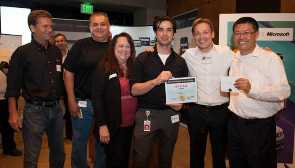‘Wii Go Places’ SMART Board Alternative Wows Innovation Fair Crowd
December 04, 2012 | Posted to: Associates, Technology
You never know when inspiration might strike.
Consider the example of Korhan Gurocak. By day, he serves as the Legal and Corporate Responsibility and Forensics manager in Information Systems (IS). By night, he is a screenwriter. While practicing the latter, he came up with a breakthrough idea that just might make a big impact on the former.
“While writing a script, I use a process where I put ideas on notes and tack them on a cork board, or I’ll simply write them on the wall,” he says. “I knew there had to be a better way, so I started researching SMART boards (made by SMART Technologies), hardware that basically digitizes the process. That’s when I learned that these devices are ridiculously expensive, costing up to $25,000.”
Along the way, Gurocak also discovered that some enterprising souls had come up with an alternative using a Wii video game system remote control working in concert with an infrared pen, a laptop and some simple software. At a total cost of just $100 (excluding the laptop), Gurocak had his high-tech scriptwriting solution.
He also had a ready-made answer when IS put out the call for entries for its annual Innovation Fair. Gurocak believed his fellow associates could benefit from his bargain-basement SMART board concept, so he assembled a team of colleagues to prove it.
Just a month later, they unveiled their idea at the fair, which for the first time in its six years was opened up to entries from all TMS departments, not just IS. “Wii Go Places,” as Gurocak’s team called it, was the runaway hit of the event. It claimed the first-place prize among the 36 projects that agreed to be judged by two cross-company panels of executives. Overall, a record 87 teams offered displays, including 39 representing non-IS business units.
Key Components – The SMART board on a budget includes: 1) an infrared pen; 2) a Wii remote; 3) laptop computer; 4) LCD projector; and 5) projection screen.
“It was an amazing experience,” says Gurocak, who was joined in the winning effort by: Terri Lee Batton, senior applications analyst; Jack Munter, applications engineer, business delivery; James Tu, Legal and eDiscovery technology manager; and Raul Yzaguirre, senior applications analyst. “Usually when you put something new out there, you have your naysayers. But everyone who came by our display was so positive, asking questions and wanting to know how it works. It was kind of surreal.”
So, how does it work? You start with a laptop or desktop computer. Then you connect that device to some sort of external display, such as an LCD projector or a TV. That’s the core set-up for many meetings at TMS, such as those built around a PowerPoint presentation.
What sets “Wii Go Places” apart is that instead of controlling the software with the laptop’s mouse, you use an infrared pen that communicates with a Wii remote that’s pointed at the display and connected to the computer (see diagram). Just point and click, on the big screen.
But it doesn’t stop there. With the right software, you can also “write” on the screen using the infrared pen–similar to writing on a dry-erase board with a dry-erase marker–and then save the work to the laptop, making it easy to share with everyone in the room as a text or image file.
The team also showed how a similar approach could be configured to allow everyone in the meeting, assuming they’re equipped with iPads or other devices of that ilk, to view and annotate the same material on their screens simultaneously while connected via Wi-Fi.

Wii Winners — Group Vice President and Chief Information Officer Zack Hicks congratulates the fair’s first-place team (left to right): Jack Munter, Business Delivery applications engineer; Raul Yzaguirre, senior applications engineer; Terri Lee Batton, senior applications analyst; Korhan Gurocak, LCR and Forensics manager; and James Tu, Legal and eDiscovery technology manager.
The bottom line: Collaboration just got a whole lot easier and cooler, not to mention cheaper. The cost for this set up is 250 times less than a full-blown SMART board with its proprietary software. And there’s essentially no compromise in capability.
“Everyone was able to see the business use,” says Gurocak. “We’ve all been in meetings where the dry-erase board won’t erase, or you end up taking a picture of the board with your camera phone and then have to transcribe the notes after the meeting. This could replace that.”
Gurocak says Zack Hicks, group vice president and chief information officer, has given the approval to set up a few conference rooms with the technology to see how it works. If the pilot program pans out, Gurocak’ s inspiration just might help make the company more efficient while also saving it a fair amount of money.
“As I understand it, the company was considering a big investment in SMART boards,” says Gurocak. “I guess it’s a good thing we did this when we did.”
By Dan Miller


Leave a Reply